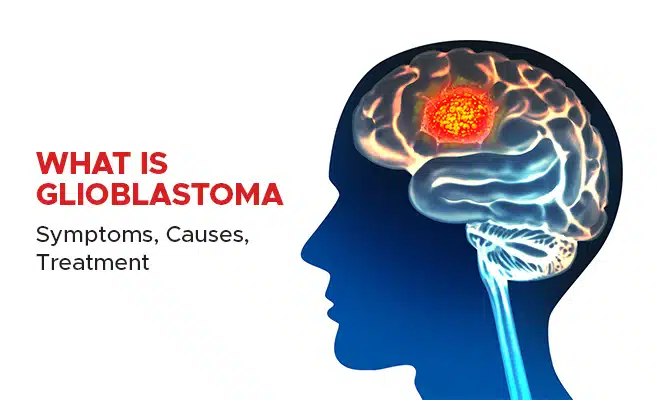What Is Glioblastoma – Symptoms, Causes, Treatment

Nearly half of all adult malignant brain tumours are glioblastomas (GBMs). Rapid growth and possible brain-wide dissemination characterise this brain malignancy. Glioblastoma symptoms are the most common type of primary brain tumour. They are brain-originating cancers, in other words. They vary significantly from metastatic, or secondary, brain tumours that initially develop in other organs before spreading to the brain—because of this.
Now that you know what is glioblastoma, it’s a crucial decision to make since primary and secondary brain tumours are treated quite differently.
What are the Different Forms of Glioblastoma?
Glioblastoma tumours can develop as either primary or secondary tumours. The most prevalent glioblastomas are primary or de novo glioblastomas, which start as a grade IV tumour without any prior evidence of grade I-III tumours in the vicinity.
More than half of all initial malignant gliomas, according to a study, are glioblastoma multiforme. The glial cells are the origin of gliomas, which are malignancies. Older patients are more frequently affected by de novo cancers, which are more aggressive. Nevertheless,
Glioblastoma symptoms can arise in anyone. Lower-grade tumours can develop into higher-grade tumours, called secondary glioblastomas. The aggressiveness of these tumours may increase as they grow over time.
Glioblastoma Symptoms
As the tumour develops and produces brain swelling, glioblastomas are particularly aggressive and patients frequently experience symptoms fairly fast. The following glioblastoma symptoms of brain enlargement and elevated pressure may appear:
- Nausea
- Puking
- Excruciating headaches
- Seizures
- Weakness
- Weariness
- Balancing difficulties
- Difficulties with vision, such as fuzzy or double vision
- Memory problems
- Thinking difficulties
- Speaking difficulties
- Personality changes
- Other symptoms may occur depending on where the tumour is located in the brain.
In the majority of instances, medical professionals are unaware of glioblastoma causes. Additionally, it might be challenging to identify the risk factors for glioblastoma. In certain instances, there seems to be a link between glioblastoma and prior radiation exposure to the head or neck.
Additionally, several inherited diseases have been linked by experts to a higher chance of glioblastoma. These illnesses include Li-Fraumeni syndrome, Turcot syndrome, and Neurofibromatosis Type 1 (NF-1). Anybody can get the tumours, although men and older people seem to develop them more frequently. A diagnosis of Glioblastoma symptoms is made at an average age of 64.
How is Glioblastoma diagnosed?
The following tests and methods are used to diagnose glioblastoma:
Neurological examination
Your doctor will question you about your signs and symptoms during a neurological exam. Your eyesight, hearing, balance, coordination, strength, and reflexes could all be tested. A brain tumour may be present in one or more of these locations, and issues in one or more of them may provide information about that area of the brain.
Imaging examinations
Your doctor can assess the location and size of your brain tumour with the use of imaging tests. When diagnosing brain tumours, MRI is frequently utilised, sometimes in conjunction with more specialised MRI imaging techniques like functional MRI and magnetic resonance spectroscopy.
CT and positron emission tomography are two more imaging procedures that may be performed (PET).
Taking a tissue sample for testing (biopsy)
Depending on your condition and the location of your tumour, a biopsy with a needle can be performed before or during surgery to remove your Glioblastoma symptom. In a laboratory, a sample of the suspicious tissue is examined to identify the types of cells present and their degree of aggression.
Your doctor can learn via specialised examinations of the tumour cells what kinds of mutations they have accumulated. This provides your doctor with hints regarding your prognosis and might influence the course of your therapy.
Treatment
Among the available glioblastoma treatment are:
Glioblastoma removal surgery
Glioblastoma removal will be carried out by your brain surgeon (neurosurgeon). The aim is to get rid of as much of the tumour as feasible. However, because glioblastoma spreads into normal brain tissue, total removal is impossible. As a result, most patients need further therapies following surgery to target the leftover cells.
Radiation treatment
Cancer cells are destroyed during radiation therapy using high-energy beams like protons or X-rays. When receiving radiation therapy, you lay on a table as a machine travels around you, aiming beams at certain regions of your brain.
Chemotherapy
Chemotherapy uses medication to destroy cancer cells. Thin, round wafers carrying chemotherapeutic treatment may be inserted in your brain during surgery in some situations. Slowly dissolving wafers release the drug and destroy cancer cells.
TTF treatment (tumour treating fields)
To stop the tumour cells from proliferating, TTF employs an electrical field. Applying sticky pads to your scalp is a part of TTF. The pads are linked to a portable device that produces an electrical field. After radiation therapy, TTF is sometimes advised in combination with chemotherapy.
Drug treatment with specific targets
Drugs that target particular defects in cancer cells that promote growth and survival are known as targeted therapies. These anomalies are attacked by the medications, which results in the death of the cancer cells.
Conclusion
The brain tumour Glioblastoma symptom is extremely aggressive and challenging to cure. Although there is no cure, therapy will concentrate on reducing the rate at which cancer spreads. Despite the dismal survival statistics for glioblastoma, several variables might affect a person’s prognosis. With the correct assistance, you can make a significant difference in your treatment options. PSRI Hospital can swiftly provide the greatest glioblastoma treatment options while providing a seamless and reliable experience when using its services.

 Book An Appointment
Book An Appointment Virtual Consultation
Virtual Consultation




